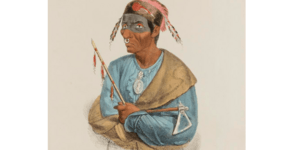Monoquet (Potawatomi chief) facts for kids
Quick facts for kids
Chief
Monoquet
Of The Tippecanoe River
|
|
|---|---|
 |
|
| Born | c. 1775 |
| Died | c. Spring 1836 Monoquet Village, Kosciusko County, Indiana
|
| Cause of death | Suspected poisoning |
| Military career | |
| Rank | Chief of the Tippecanoe River |
| Battles/wars | Battle of Tippecanoe |
Chief Monoquet (also called Muh-neck-o-it) was an important Potawatomi Native American leader. He lived in Indiana during the early 1800s. People believe he was born around 1775.
He became a young warrior when he was about 15 years old. By 1832, when settlers from Europe started arriving, he was one of the most powerful chiefs in Kosciusko County.
Contents
Who Was Chief Monoquet?
Chief Monoquet was a respected leader of the Potawatomi people. He was one of five main chiefs living in Kosciusko County. His influence was strong among his people.
His Home Village
Chief Monoquet's village was a special place. It was located on the north side of the Tippecanoe River. This area is now near IN-15 N and Monoquet Road in Kosciusko County, Indiana.
The village covered about three acres of land. It had around fifteen wigwams. These homes were made from bark and were spread out across the village.
What He Looked Like
In 1835, a man named William C. Graves described Chief Monoquet. Graves was an early teacher in Leesburg, IN. He wanted to record what the local chiefs looked like.
Chief Monoquet was about 60 years old at that time. He was a bit thin and taller than average. He had dark skin and a high forehead. His eyes were small and bright, and his nose was hooked. He had a serious look on his face.
A Mysterious End
Chief Monoquet died in the spring of 1836. His death happened before his people were forced to move. Many people believed he died from poisoning.
Some members of his tribe suspected a Native American woman. She had been visiting from Michigan. This suspicion caused fear and rumors.
The Journey West
After Chief Monoquet's death, the Native Americans of Kosciusko County faced a difficult time. They were eventually forced to leave their homes. They had to move far away to Kansas. This was a sad and challenging journey for them.

